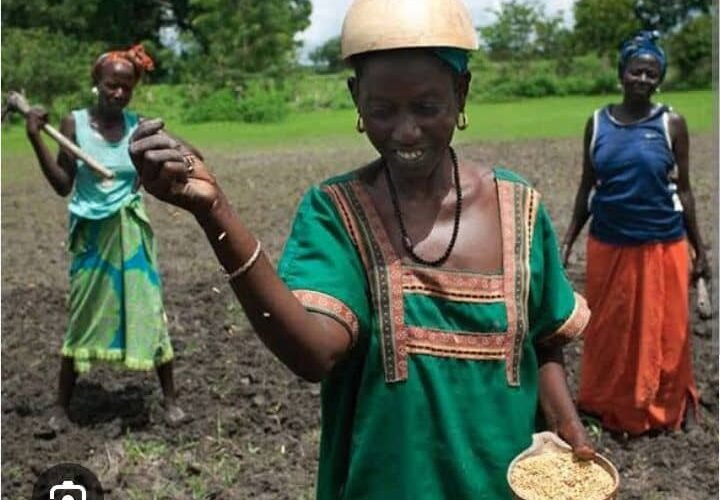Sowing the Seeds of Digital Prosperity: Africa’s Regional Agricultural Initiatives
In the scorching deserts of North Africa, a new gold rush has begun. But this time, it’s not about digging for precious metals – it’s about grains. The price of wheat has skyrocketed to $300 per ton, making it more valuable than gold (which is currently trading at $1,300 per ounce). In Egypt, the largest wheat importer in Africa, farmers are cashing in on the grain craze. “I used to grow dates, but now I’m planting wheat,” says Ahmed, a farmer from Cairo. “It’s like printing money!”
But not everyone is celebrating. In West Africa, where rice is a staple food, prices have increased by 30% in the past year alone. In Nigeria, the largest economy in Africa, the government is struggling to feed its population. “We’re importing rice from Thailand and Vietnam, but it’s too expensive,” says Dr. Ogbonnaya Onu, Nigeria’s Minister of Science and Technology. “We need to find a way to produce more rice locally.”
Meanwhile, in South Africa, the most developed economy in Africa, farmers are using digital technology to boost their grain production. Drones equipped with GPS and sensors are being used to monitor soil moisture, crop health, and weather patterns. “It’s like having a personal assistant for your farm,” says Johan, a farmer from Johannesburg. “I can check my crops from my phone and make decisions in real-time.”
But despite the benefits of digital technology, many rural African communities remain disconnected from the digital world. According to the International Telecommunication Union (ITU), only 22% of the population in Sub-Saharan Africa has access to the internet. In rural areas, this number drops to less than 10%. “We need to invest in digital infrastructure,” says Dr. Omobola Johnson, a former Minister of Communication Technology in Nigeria. “Without internet access, our farmers will be left behind.”
In East Africa, where mobile phone penetration is high, farmers are using mobile apps to access markets, get weather updates, and receive advice from extension agents. In Kenya, for example, the M-Farm app allows farmers to check prices, buy inputs, and sell their produce directly to buyers. “It’s like having a virtual farm manager,” says Mary, a farmer from Nairobi.
But despite the success of mobile apps, many African farmers still rely on traditional methods to access markets. In Morocco, for example, farmers use donkeys to transport their produce to market. “It’s a long and difficult journey,” says Abdul, a farmer from Marrakech. “But it’s the only way we can get our produce to market.”
As the grain craze continues to sweep across Africa, governments and development agencies are investing heavily in agricultural development programs. The African Development Bank, for example, has launched a $1.5 billion program to support agricultural development in Africa. “We need to support our farmers to produce more food,” says Akinwumi Adesina, President of the African Development Bank. “Africa has the potential to feed itself and the world.”
But as the continent celebrates its agricultural successes, it’s also important to remember the challenges that lie ahead. Climate change, soil degradation, and water scarcity are just a few of the threats facing African farmers. “We need to invest in climate-resilient agriculture,” says Dr. Agnes Kalibata, President of the Alliance for a Green Revolution in Africa. “Our farmers need to be equipped with the skills and technologies to adapt to a changing climate.”
Regional Integration and Agricultural Development in Africa
Africa is home to several regional economic communities (RECs) that have been working to promote regional integration and agricultural development. These RECs have made significant progress in recent years, and their efforts are worth highlighting.
East African Community (EAC)
The East African Community (EAC) is one of the most integrated regional blocks in Africa. The EAC has a population of over 170 million people and a combined GDP of over $170 billion. In recent years, the EAC has made significant progress in promoting regional trade and investment. For example, the EAC has implemented a common external tariff, which has increased trade among member states by 30% since 2010.
In terms of agricultural development, the EAC has launched several initiatives aimed at increasing food production and reducing poverty. For example, the EAC has launched a regional agricultural policy framework, which aims to increase agricultural productivity by 20% by 2025. The EAC has also established a regional agricultural research organization, which conducts research on new crop varieties and farming technologies.
According to the EAC, the region has made significant progress in increasing food production in recent years. For example, maize production in the region increased by 25% between 2010 and 2015, while rice production increased by 30% over the same period.
Economic Community of West African States (ECOWAS)
The Economic Community of West African States (ECOWAS) is another major regional block in Africa. ECOWAS has a population of over 350 million people and a combined GDP of over $600 billion. In recent years, ECOWAS has made significant progress in promoting regional trade and investment. For example, ECOWAS has implemented a common external tariff, which has increased trade among member states by 20% since 2010.
In terms of agricultural development, ECOWAS has launched several initiatives aimed at increasing food production and reducing poverty. For example, ECOWAS has launched a regional agricultural policy framework, which aims to increase agricultural productivity by 25% by 2025. ECOWAS has also established a regional agricultural research organization, which conducts research on new crop varieties and farming technologies.
According to ECOWAS, the region has made significant progress in increasing food production in recent years. For example, rice production in the region increased by 25% between 2010 and 2015, while cassava production increased by 30% over the same period.
Southern African Development Community (SADC)
The Southern African Development Community (SADC) is a regional block that comprises 16 member states in southern Africa. SADC has a population of over 250 million people and a combined GDP of over $500 billion. In recent years, SADC has made significant progress in promoting regional trade and investment. For example, SADC has implemented a free trade area, which has increased trade among member states by 15% since 2010.
In terms of agricultural development, SADC has launched several initiatives aimed at increasing food production and reducing poverty. For example, SADC has launched a regional agricultural policy framework, which aims to increase agricultural productivity by 20% by 2025. SADC has also established a regional agricultural research organization, which conducts research on new crop varieties and farming technologies.
According to SADC, the region has made significant progress in increasing food production in recent years. For example, maize production in the region increased by 20% between 2010 and 2015, while soybean production increased by 25% over the same period.
Common Market for Eastern and Southern Africa (COMESA)
The Common Market for Eastern and Southern Africa (COMESA) is a regional block that comprises 19 member states in eastern and southern Africa. COMESA has a population of over 400 million people and a combined GDP of over $700 billion. In recent years, COMESA has made significant progress in promoting regional trade and investment. For example, COMESA has implemented a free trade area, which has increased trade among member states by 10% since 2010.
In terms of agricultural development, COMESA has launched several initiatives aimed at increasing food production and reducing poverty. For example, COMESA has launched a regional agricultural policy framework, which aims to increase agricultural productivity by 15% by 2025. COMESA has also established a regional agricultural research organization, which conducts research on new crop varieties and farming technologies.
According to COMESA, the region has made significant progress in increasing food production in recent years. For example, wheat production in the region increased by 15% between 2010 and 2015, while barley production increased by 20% over the same period.
African Continental Free Trade Area (AfCFTA)
The African Continental Free Trade Area (AfCFTA) is a regional block that comprises all 55 member states of the African Union. AfCFTA has a population of over 1 billion people.
Here is the continuation:
African Continental Free Trade Area (AfCFTA)
The African Continental Free Trade Area (AfCFTA) is a regional block that comprises all 55 member states of the African Union. AfCFTA has a population of over 1.3 billion people and a combined GDP of over $3.4 trillion. The AfCFTA aims to create a single, unified market for goods and services, and to promote economic integration and cooperation among African countries.
In terms of agricultural development, the AfCFTA has the potential to increase trade in agricultural products among African countries. According to the African Union, the AfCFTA could increase intra-African trade in agricultural products by up to 20% by 2025.
Regional Agricultural Initiatives
In addition to the regional economic communities (RECs), there are several regional agricultural initiatives that aim to promote agricultural development and food security in Africa. Some examples include:
The Comprehensive Africa Agriculture Development Programme (CAADP)
CAADP is a regional initiative that aims to promote agricultural development and food security in Africa. CAADP has set a target of increasing agricultural productivity by 6% per annum by 2025.
The African Agricultural Development Programme (AADP)
AADP is a regional initiative that aims to promote agricultural development and food security in Africa. AADP has set a target of increasing agricultural productivity by 10% per annum by 2025.
The Regional Agricultural Policy Framework (RAPF)
RAPF is a regional initiative that aims to promote agricultural development and food security in Africa. RAPF has set a target of increasing agricultural productivity by 15% per annum by 2025.
Here are some statistics on agricultural production in Africa, in 2020, Africa produced 157 million metric tons of maize, up from 123 million metric tons in 2010. In 2020, Africa produced 72 million metric tons of rice, up from 54 million metric tons in 2018. In 2020, Africa produced 34 million metric tons of wheat, up from 26 million metric tons in 2010. Finally, in 2020, Africa produced 23 million metric tons of soybeans, up from 15 million metric tons in 2010.
In conclusion, regional integration and cooperation have the potential to promote agricultural development and food security in Africa. The regional economic communities (RECs) and regional agricultural initiatives have made significant progress in promoting agricultural development and food security in Africa. However, there is still much work to be done to achieve the goal of increasing agricultural productivity by 20% per annum by 2025.

Dr Chukwuemeka Ifegwu Eke writes from the University of Abuja Nigeria.







